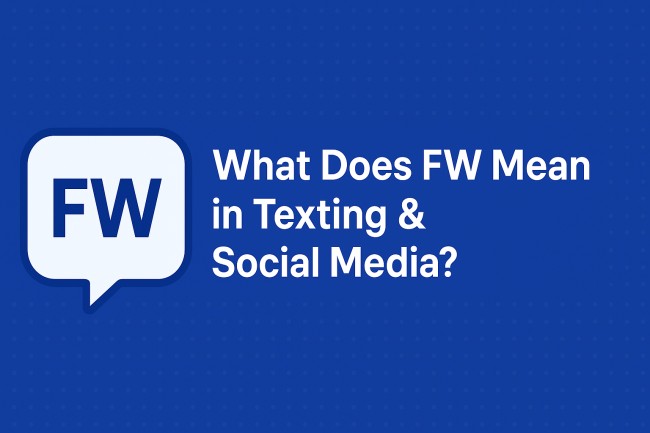
The world of digital slang changes fast. Acronyms evolve. Meanings shift with context. Among these, “FW” has gained traction. From casual texts to Instagram captions, its presence is hard to miss.
But the interpretation depends on how and where it’s used. Understanding what “FW” means is key to decoding online chatter.
FW Meaning in Texting
In most text conversations, “FW” stands for “Forward.” It signals the act of sending content originally written by someone else. The context often appears in email subject lines, where users prefix messages with “FW:” to show it’s a forwarded message.
Example:
- Email Subject: FW: Team Meeting Notes
Beyond email, the use in texting can mimic this function. A user may begin a message with “FW:” when sharing something received earlier, especially in professional or formal exchanges.
FW on Social Media
On platforms like Twitter, TikTok, and Instagram, meanings shift.
One of the most common interpretations in casual conversation is:
- FW = F* With**
Used informally, it expresses affiliation, support, or involvement. The tone can be playful or serious depending on the audience and tone.
Examples:
- “I FW that song heavy.”
- “If you FW me, prove it.”
It signals interest, connection, or emotional alignment. Among close circles, it can carry weight.
Contextual Meanings of FW
“FW” does not have a single definition. It morphs with the tone, platform, and sentence structure. Each use paints a different picture:
1. FW as ‘Forward’ in Email/Texting:
Used in a professional or informative tone. Appears in mail threads, message chains, and documents.
2. FW as ‘F* With’ in Slang:**
Colloquial and expressive. Often used to show appreciation, respect, or emotional link. More common in Gen Z speech, hip-hop culture, and meme captions.
3. FW as a Nickname or Tag:
In gaming or community circles, “FW” might also be an abbreviation for usernames, team tags, or identity brands like:
- “FW Clan” in eSports
- “FW” as an abbreviation in usernames
Understanding usage demands a glance at surrounding text and tone.
Examples Across Platforms
The meaning of FW becomes clear when placed in real-world settings. Each example showcases a different usage style.
1. Instagram Caption:
- “Only real ones FW me 🖤”
Implies loyalty or connection with followers.
2. TikTok Comment:
- “I don’t FW clowns like that 😂”
Highlights disapproval or rejection in a funny tone.
3. Snapchat Story:
- “FW: Weekend Vibes 🍻”
Shares content received from someone else.
4. Email Chain:
- “FW: Quarterly Budget Review”
Standard business communication.
The tone dictates the interpretation. While professional spaces rely on “forward,” social circles twist it for emotional or cultural flavor.
Slang isn’t just filler—it shapes tone, meaning, and engagement. “FW” allows users to compress emotion or intent into two letters. It saves space while signaling affiliation, reaction, or function.
The brevity appeals to fast-paced digital interactions. In comments or replies, using “FW” instead of full phrases keeps communication quick and stylish.
It also helps mark content status. In formal messages, “FW” flags forwarded data. In casual use, it shows alignment or disconnection.
Common Variants and Misinterpretations
Acronyms are often misread. Especially when tone isn’t clear. Here’s how users sometimes confuse “FW” with other abbreviations:
- FW vs. FWB: FWB stands for “Friends With Benefits.” Entirely different from FW, which focuses on support or content sharing.
- FW vs. FWIW: FWIW means “For What It’s Worth.” It delivers opinion or value-based input. FW lacks this nuance.
- FW vs. FYI: FYI (For Your Information) often appears with FW in emails. They serve different purposes – FW indicates origin, FYI states intent.
Knowing the difference prevents confusion, especially in professional settings.
When to Use or Avoid FW
Usage depends on audience and platform. Some settings call for clarity over coolness.
Appropriate Scenarios:
- Forwarding emails in office settings
- Informal texting with friends
- Posting captions where slang fits the audience
Avoid FW When:
- Communicating with formal audiences unfamiliar with internet slang
- Addressing multi-generational or cross-cultural groups
- Creating documents requiring absolute clarity
Understanding where FW fits ensures the message lands right.
Conclusion
“FW” packs meaning into two letters. Whether signaling a forwarded message or expressing emotional alignment, it shapes digital dialogue in compact form. Recognizing the tone, platform, and audience makes the difference.
In texting, it speeds up replies. In social media, it builds identity. In email threads, it keeps chains organized. The meaning isn’t fixed – but its value in modern communication is clear.
FAQs
Q1: Can FW be used professionally?
Yes, when referring to “Forward” in emails or message threads. Avoid slang usage in formal settings.
Q2: Is FW slang offensive?
It can include profanity depending on the context. In casual conversations, it’s often harmless, but usage should match audience expectations.
Q3: What is the difference between FW and FWD?
Both refer to forwarding, but “FWD” is more common in professional email threads. “FW” is more shorthand in text or informal mail use.
Q4: Why is FW popular among Gen Z?
It’s fast, expressive, and easy to use. It also fits well into music culture, memes, and viral trends.
Q5: Does FW mean the same on every platform?
No. It varies. Always check the surrounding context to understand the meaning correctly.

